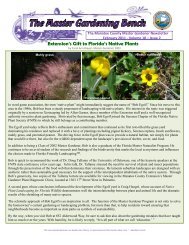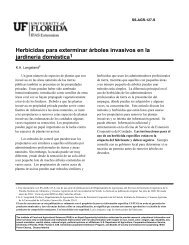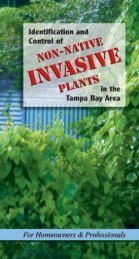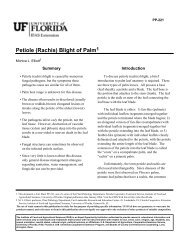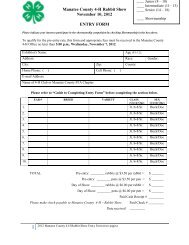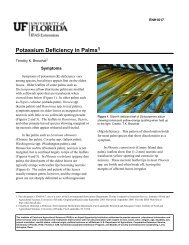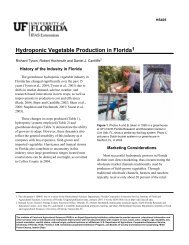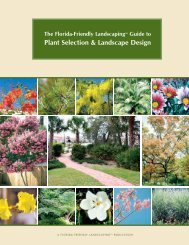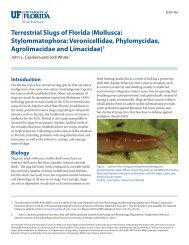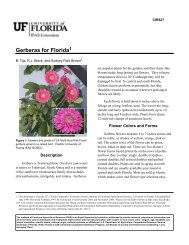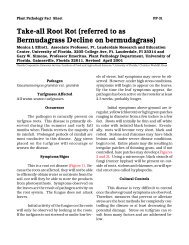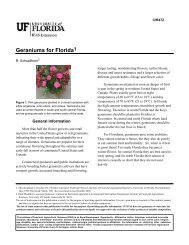By Amy Stripe, Master Gardener 2008 - Manatee County Extension ...
By Amy Stripe, Master Gardener 2008 - Manatee County Extension ...
By Amy Stripe, Master Gardener 2008 - Manatee County Extension ...
Create successful ePaper yourself
Turn your PDF publications into a flip-book with our unique Google optimized e-Paper software.
Spring’s Dazzling Trees<br />
Pink Trumpet Tree<br />
<strong>By</strong> <strong>Amy</strong> <strong>Stripe</strong>, <strong>Master</strong> <strong>Gardener</strong> <strong>2008</strong><br />
The <strong>Manatee</strong> <strong>County</strong> <strong>Master</strong> <strong>Gardener</strong> Newsletter<br />
April 2013 ‐ Volume 12 – Issue 4<br />
Florida visitors and residents alike are in for a treat right about now,<br />
as some of our tropical trees put on their spectacular show of color.<br />
Silver Trumpet Tree<br />
Jacaranda<br />
Royal Poinciana<br />
Photographs courtesy of Floridata.com<br />
At this very moment, silver trumpet trees (Tabebuia caraiba) are<br />
dressed in bright yellow blossoms which contrast beautifully with<br />
their silvery-gray bark. Florida boasts many other Tabebuia<br />
species, however, which you will see blooming over the course of<br />
late winter and into early summer, sporting pink, white, or yellow<br />
flowers in various bright shades. Collectively they are all generally<br />
called “trumpet trees” or “tabebuias.” In addition to T. caraiba,<br />
we commonly see T. heterophylla (“pink trumpet tree”), T.<br />
impetiginosa (“purple tabebuia”), and T. heterophylla DC Britton<br />
(“white cedar”).<br />
Usually, tabebuias will drop their leaves before flowering and then<br />
set flowers in clusters at the ends of their branches. Many have a<br />
distinctively oblong leaf and corky or craggy bark, and an<br />
asymmetrical canopy. In our area, the yellow blooms first, followed<br />
by pink then white.<br />
Jacaranda (Jacaranda mimosafolia) is, like tabebuia, another<br />
deciduous native of the tropical Americas. No other tree is as<br />
distinctive in color as the jacaranda, with its electric blue-lavender<br />
flowers that explode into bloom between April and June and<br />
continue blooming for up to 8 weeks. Growing up to 40 feet tall<br />
with an equal or greater spread, it makes a nice shade tree when<br />
not in bloom.<br />
Perhaps the world’s most beautiful tree is the royal poinciana<br />
(Delonix regia), a native of Madagascar that has been embraced<br />
with enthusiasm in the tropics and in particular the Caribbean,<br />
where it is called “flamboyant tree” or “flame tree.” Blooming in<br />
early summer and sometimes again in late summer, its blindingly<br />
vibrant red-orange flowers are without equal. The fernlike leaflets<br />
of this tree make it a lovely specimen even when not in bloom,<br />
though with a height of up to 40 feet and a spread of up to 60 feet,<br />
you need to give a royal poinciana plenty of room.<br />
As with the tabebuia and jacaranda, royal poinciana will produce<br />
long seed pods that might be considered a litter nuisance, or an<br />
opportunity for another beautiful tropical tree to grace us with its<br />
bountiful blossoms.<br />
“Nature, to be commanded, must be obeyed.” ~ Francis Bacon
<strong>Manatee</strong> <strong>County</strong> Agriculture and <strong>Extension</strong> Service<br />
1303 17 th Street West - Palmetto, FL 34221<br />
Telephone: (941) 722-4524<br />
http://manatee.ifas.ufl.edu<br />
<strong>Master</strong> <strong>Gardener</strong>s <strong>Amy</strong> <strong>Stripe</strong> & Joy Derksen, Co-editors<br />
Contents reviewed & edited by Lisa Hickey, <strong>Extension</strong> Agent.<br />
Send a photo or gardening problem via e-mail to the <strong>Master</strong> <strong>Gardener</strong>s<br />
at <strong>Manatee</strong>MG@gmail.com or visit them at the <strong>County</strong> <strong>Extension</strong> Office<br />
Monday – Friday 9:00 a.m. to 4:00 p.m.; closed on Wednesday.<br />
“What’s That”<br />
<strong>By</strong> Joy Derksen, <strong>Master</strong> <strong>Gardener</strong> 2004<br />
A surprising new plant appeared this winter in the <strong>Master</strong> <strong>Gardener</strong> demonstration<br />
vegetable garden. What caught my eye was this large sprawling bush covered with small<br />
purple/white flowers buzzing with bees and visited by butterflies. “What’s that” I asked,<br />
and “Why is it in the kitchen garden”<br />
I thought perhaps a plant had escaped the butterfly garden and seeded itself in an empty<br />
spot. It had pods like a bean plant at the end of long drooping stems. I was told to taste a<br />
pod, which had the crunch of a pea pod and yet tasted like a radish. Turns out this is a<br />
rattail radish (Raphanus caudatus), introduced into the United States in the late 1800s. It<br />
belongs to the radish family although you do not eat the root like more familiar radishes.<br />
The pods and flowers are the edible parts.<br />
Although we grew the rattail radish in the winter, it likes hot weather and sandy neutral soil.<br />
The pods can be used in salads, stir-fry, or raw with dip. You might want to try this oldfashioned<br />
plant in either your vegetable garden or the butterfly garden. Rattail radish needs<br />
a more attractive name for what turns out to be an unusual gardening plant good for people,<br />
bees, and butterflies. A Washington Post writer suggested “spicy bean” when serving it to<br />
friends; what can you imagine More information is available at:<br />
http://www.missouribotanicalgarden.org/gardens-gardening/your-garden/plant-finder/plantdetails/kc/a761/raphanus-sativus-caudatus.aspx.<br />
2
April Chores in the Garden<br />
<strong>By</strong> Joy Derksen, <strong>Master</strong> <strong>Gardener</strong> 2004<br />
We’ve had a mild winter this year, and spring seems<br />
to have lasted for months. Now is the time to get<br />
out there and garden before the weather turns really<br />
hot. Time to fertilize, mulch, and prune for the<br />
coming summer. Prune spring blooming shrubs<br />
now. Azaleas should be pruned and fertilized after<br />
blooming. They need a special acid-forming<br />
fertilizer once each season; mature plants get 4<br />
ounces each time. Azaleas should be mulched with<br />
oak leaves or pine straw which allow good drainage<br />
and provide natural acids to our alkaline soils.<br />
Lawns are greening<br />
up. Watch out for<br />
chinch bugs on new<br />
growth. Control<br />
broad leaf weeds that<br />
invaded during<br />
winter now with an<br />
herbicide or hand<br />
pulling. Herbicides<br />
are more effective<br />
while the<br />
temperature is below<br />
80 degrees.<br />
Citrus should be on their way to developing next<br />
year’s fruit. Citrus greening is becoming more<br />
common in the county. If you notice mottled leaves<br />
and a symmetrical fruit, you might want to bring a<br />
sample branch in to the <strong>Extension</strong> center or check<br />
out this publication:<br />
http://www.crec.ifas.ufl.edu/extension/greening/sym<br />
ptoms.shtml. To control rust and spider mites, apply<br />
a horticultural oil. You may apply a nutritional<br />
spray when 2/3 of the petals have fallen; the copper<br />
in the nutritional spray will also help control Scab<br />
and Melanose. Be sure to read the labels and only<br />
apply products registered for use on citrus.<br />
Insects are starting to appear as the weather<br />
warms. Aphids are already feeding. You can use<br />
a horticultural oil or an insecticidal soap to spot<br />
spray them or blow them off the plants with a<br />
stiff spray of the hose. Look for them on the<br />
new growth. I recently saw my first tiny<br />
lubbers. Newly hatched black and yellow<br />
grasshoppers travel in groups climbing up onto<br />
nearby plants. The young ones can be dropped<br />
into a bucket of soapy water, squished, or<br />
sprayed with bifenthrin (Talstar). As they grow<br />
to 4 or 5 inches, no insecticide seems effective.<br />
They are also<br />
poisonous so predators<br />
ignore them.<br />
Another insect<br />
unaffected by the<br />
cold seems to be the<br />
Sri Lanka weevil.<br />
This small whitish<br />
gray weevil with<br />
dark spots on its<br />
back actively feeds<br />
in the daytime. It<br />
chews the edges of<br />
leaves giving them a shredded look. This is an<br />
invasive pest and seems to eat almost<br />
everything. The University of Florida indicates<br />
the adult weevils can be controlled by spraying<br />
the leaves with bifenthrin (Talstar) and acephate<br />
(Orthene). If you are spraying fruit-bearing<br />
trees, make sure citrus or other fruit trees are<br />
specified on the label.<br />
Vegetable lovers, get your warm season plants<br />
ready. A Florida Vegetable Guide is available<br />
online http://edis.ifas.ufl.edu/vh021. Pull out the<br />
old plants and turn some compost into your soil.<br />
Okra, radishes, lima and bush beans, black-eyed<br />
peas, eggplants, corn, peppers, sweet potatoes,<br />
and melons can go into the ground now.<br />
3
Landscape Plants and Their Evil (Invasive) Twins<br />
<strong>By</strong> <strong>Amy</strong> <strong>Stripe</strong>, <strong>Master</strong> <strong>Gardener</strong> <strong>2008</strong><br />
A non‐native invasive plant is one that hitched a ride in or was introduced to Florida<br />
from elsewhere and that outgrows and displaces native species. Working with the<br />
Florida Exotic Pest Plant Council (FLEPPC), many Florida commercial growers are<br />
attempting to stop the production and sale of some of these species.<br />
However, some common and not‐so‐common invasive landscape plants may still be<br />
available to the homeowner, so it is important to know if you’re buying a good guy<br />
or its invasive imposter. Sometimes it is difficult to tell the difference, so go armed<br />
with scientific names as well as common names, and shop at a reputable nursery.<br />
Good Guy<br />
Bad Guy<br />
Wild petunia (Ruellia caroliniensis) Mexican petun ia (Ruellia simplex or R.<br />
brittoniana)<br />
Dwarf oyster plant (Tradescantia “Dwarf<br />
Tricolor”)<br />
Oyster plant ( Tradescantia spathacea; also<br />
Rhoeo spathacea or Rhoeo discolo r)<br />
Snake plant (Sansevieria trifasciata) Snake plant (Sansevieria hyacinthoides)<br />
Inkberry (Scaevola plumieri)<br />
Beach naupaka (Scaevola taccada)<br />
Sweet acacia tree (Acacia farnesiana) Lead tree (Leucaena leucocephala)<br />
Hong Kong orchid tree (Bauhinia x Orchid tree (Bauhinia variegata)<br />
blakeana)<br />
Fakahatchee grass (Tripsacum<br />
Cogon grass (Imperata cylindrical)<br />
dactyloides)<br />
For more information visit h ttp://ifas.ufl.edu or http://fleppc.org.<br />
Good Guy<br />
Bad Guy<br />
Wild petunia<br />
Ruellia caroliniensis<br />
Mexican petunia<br />
Ruellia simplex<br />
continued on page 5<br />
4
continued from page 4<br />
Good Guy<br />
Bad Guy<br />
Dwarf oyster plant<br />
Tradescantia “Dwarf Tricolor”<br />
Oyster plant<br />
Tradescantia spathacea<br />
Snake plant<br />
Sansevieria trifasciata<br />
Snake plant<br />
Sansevieria hyacinthoides<br />
Inkberry<br />
Scaevola plumieri<br />
Beach naupaka<br />
Scaevola taccada<br />
Fakahatchee grass<br />
Tripsacum dactyloides<br />
Cogon grass<br />
Imperata cylindrical<br />
5
Houseplants:<br />
Nature’s<br />
Clean Air Machines<br />
<strong>By</strong> Roger Boos and Nicole Pinson,<br />
<strong>Master</strong> <strong>Gardener</strong>s 2012<br />
Archeologists and historians say that<br />
there is evidence that the ancient<br />
Greeks and Romans cultivated<br />
houseplants. Perhaps one of man’s<br />
earliest ancestors, sitting in his cave,<br />
decided that in addition to the nice<br />
artwork on the walls, his place needed<br />
a homey touch. He saw all of the<br />
greenery outdoors and the rest is<br />
history.<br />
Thanks to explorers and modern<br />
transportation, we have access to<br />
exotic species from all over the globe.<br />
From the humble Apidistra spp. (“cast<br />
iron plant”) to a spectacular orchid,<br />
plants the beauty and splendor of<br />
nature indoors. They are living<br />
organisms that we care for and<br />
nurture much in the same way as our<br />
household pets.<br />
Are they a part of our world or is it<br />
really the other way around We’ve<br />
talked about their contribution to our<br />
souls, now for a bit of science. The<br />
amazing ability of plants to purify the<br />
air we breathe fundamentally affects<br />
human life. Why bother with<br />
houseplants We can’t afford not to!<br />
Why Houseplants Are Important<br />
People spend more than 90% of their<br />
daily lives indoors. And the EPA lists<br />
indoor air pollution as one of the top<br />
five threats to public health. Sources<br />
of indoor air pollution include carpet,<br />
furnishings, adhesives, dry cleaning,<br />
detergents, paper products, glues and<br />
resins, tobacco smoke, electronic<br />
devices, paints, stains and varnishes,<br />
and pressed wood and fiberboard.<br />
Based on research by NASA as well as<br />
other organizations, three averagesized<br />
floor plants or six average‐sized<br />
tabletop plants significantly improve<br />
air quality. Indoor pollutants that<br />
houseplants tackle include<br />
formaldehyde, xylene, toluene,<br />
ammonia, benzene, trichloromethane<br />
and of course, carbon dioxide.<br />
Which Houseplants Are Most Effective<br />
In the NASA study, the plants found to<br />
have good air purifying abilities<br />
include many of the most commonly<br />
cultivated species, including:<br />
• Dracaena spp. Examples<br />
include D. deremensis “Janet<br />
Craig," D. marginata, D.<br />
continued on page 7<br />
6
continued from page 6<br />
• fragrans ‘Massangeana’ or corn<br />
plant and D. deremensis<br />
‘Warneckii’<br />
• Philodendron spp. (P. cordatum<br />
or heartleaf philodendron and<br />
P. domesticum or elephant ear<br />
philodendron<br />
• Aglaonema modestum or<br />
Chinese evergreen<br />
• Epipremnum aureum or golden<br />
pothos<br />
• Sansevieria trifaciata or snake<br />
plant<br />
• Hedera helix orEnglish ivy<br />
• Chamaedorea sefritzii or<br />
bamboo palm<br />
• Spathyphyllum spp. or spathe<br />
or peace lily<br />
• Chlorophytum comosum or<br />
spider plant<br />
Please note that many houseplants are<br />
invasive when planted outdoors in the<br />
landscape. They have the ability to<br />
tolerate a wide range of conditions.<br />
Please use caution and check with the<br />
UF/IFAS <strong>Extension</strong> Office before<br />
planting indoor houseplants outdoors.<br />
For more information on houseplants,<br />
including their care, visit<br />
http://edis.ifas.ufl.edu, e‐mail a<br />
<strong>Manatee</strong> <strong>County</strong> <strong>Master</strong> <strong>Gardener</strong> at<br />
manateeMG@gmail.com or call 941‐<br />
722‐4524 and ask to speak with a<br />
<strong>Master</strong> <strong>Gardener</strong>.<br />
Dracaena ,’Marginata’<br />
Chinese evergreen<br />
Corn plant<br />
Golden pothos<br />
‘Janet Craig’ Spider plant English ivy<br />
7
April<br />
Calendar of Events<br />
Date Time Event<br />
Ask a <strong>Master</strong> <strong>Gardener</strong> – Rocky Bluff Library – 6750 US Highway 301 N., Ellenton. Visit the <strong>Extension</strong> <strong>Master</strong><br />
2 nd & 4 th<br />
Saturday<br />
10:00 a.m.–1:00 p.m.<br />
<strong>Gardener</strong> information table and get answers to your gardening questions.<br />
2 nd Ask a <strong>Master</strong> <strong>Gardener</strong> – South <strong>Manatee</strong> Library – 6081 26 th Street West, Bradenton. Visit the <strong>Extension</strong> <strong>Master</strong><br />
Saturday 10:00 a.m.‐1:00 p.m.<br />
<strong>Gardener</strong> information table and get answers to your gardening questions.<br />
Maintain and Sharpen Your Garden Tools – Learn how to maintain and sharpen your garden tools. Students<br />
may bring their tools for possible demonstration. Although we would love to, time does not permit us to sharpen<br />
April 13 9:00 a.m.‐11:00 a.m. everyone’s tools that are brought to class. We will demonstrate the “how to” so that you can sharpen and maintain<br />
your tools at home. Presented by John Dawson, <strong>Master</strong> <strong>Gardener</strong>. Register online at http://manatee.ifas.ufl.edu or<br />
call the <strong>Master</strong> <strong>Gardener</strong>s at (941) 722‐4524.<br />
<strong>Extension</strong> <strong>Master</strong> <strong>Gardener</strong> Plant ID Tour – Stroll through the De Soto National Memorial and Riverview Pointe<br />
April 13 9:00 a.m.‐11:00 a.m.<br />
Preserve to learn more about Florida’s native plants and inhabitants of a coastal habitat. Suitable for all ages. The<br />
hike begins in the parking area of the De Soto National Memorial Park and enters into the Riverview Preserve at 8250<br />
DeSoto Memorial Highway, Bradenton. Call the <strong>Master</strong> <strong>Gardener</strong>s at (941) 722‐4524 to register.<br />
Growing in Small Places – Container Gardening Workshop – This workshop will address soil types, a variety of<br />
containers, and will also describe design elements of what plants to use including plant height, texture, and color to<br />
April 16 1:30 p.m.‐3:30 p.m.<br />
create pleasing combinations of vegetables, flowers, and herbs. The program will begin with a demonstration of how<br />
to assemble a container garden from two five gallon buckets. Bring two five gallon buckets and swap for an<br />
assembled gardening bucket. Presented by Lisa Hickey, <strong>Extension</strong> Agent. Register online at<br />
http://manatee.ifas.ufl.edu or call the <strong>Master</strong> <strong>Gardener</strong>s at (941) 722‐4524.<br />
Invasive Plant Workshop – Beware! Many common yard plants are actually alien invaders. Non‐native, invasive<br />
species have thrived throughout Florida, threatening native vegetation and the wildlife on which it depends. In this<br />
April 17 10:00 a.m.‐Noon workshop, participants will learn how to identify key invasive species, the threats they pose to native vegetation and<br />
wildlife, and how they can be prevented throughout the landscape. Presented by Michelle Atkinson, Florida‐Friendly<br />
Landscaping Coordinator. Register online at http://manatee.ifas.ufl.edu or call Michelle at (941) 722‐4524.<br />
Florida‐Friendly Landscaping Combo – Compost and Rain Barrel Workshop ‐ Learn how to turn your<br />
kitchen scraps and yard waste into useful soil amendments with details on how to set up home compost bins. Leave<br />
April 20 9:00 a.m.‐Noon<br />
with a bin to start creating your own compost. Fee for compost bin. Learn how to install, paint, and maintain a<br />
functional rain barrel. Bring your truck or car with a large trunk and leave with your own rain barrel. Start conserving<br />
today! Fee for rain barrel. Presented by Michelle Atkinson, Florida‐Friendly Landscaping Coordinator. Register<br />
online at http://manatee.ifas.ufl.edu or call Michelle at (941) 722‐4524.<br />
<strong>Extension</strong> <strong>Master</strong> <strong>Gardener</strong> Plant ID Tour – Stroll through Emerson Point Preserve to learn more about Florida’s<br />
April 20 9:00 a.m.‐11:00 a.m. native plants and inhabitants of a coastal habitat. Suitable for all ages. Tour begins in the tower parking area at 5801<br />
17 th St. W., Palmetto. Call the <strong>Master</strong> <strong>Gardener</strong>s at (941) 722‐4524 to register.<br />
<strong>Extension</strong> <strong>Master</strong> <strong>Gardener</strong> Plant ID Tour – Stroll through the Robinson Preserve’s salt marshes to learn more<br />
April 21 9:00 a.m.‐11:00 a.m. about Florida’s native plants and inhabitants of a coastal habitat. Suitable for all ages. Tour begins in parking area by<br />
main entrance at 1704 99 th St. NW, Bradenton. Call the <strong>Master</strong> <strong>Gardener</strong>s at (941) 722‐4524 to register.<br />
Lowdown on Lawn Irrigation – This class satisfies the irrigation education portion of the <strong>Manatee</strong> <strong>County</strong><br />
April 22 1:30 p.m.‐4:30 p.m.<br />
Outdoor Water Conservation Rebate Program. Tune up your sprinkler system, learn how to adjust the timer and<br />
sprinklers, improve uniformity, eliminate water waste, and cut costs. Presented by Lisa Hickey, <strong>Extension</strong> Agent.<br />
Register online at http://manatee.ifas.ufl.edu or call Joann at (941) 722‐4524.<br />
Pondscaping, Florida‐Friendly Style ‐ Turf planted down to the water’s edge often requires frequent mowing.<br />
The result is grass clippings entering the pond, which contribute to increased growth of weeds and algae. In this<br />
April 24 1:00 p.m.‐3:00 p.m. workshop, learn about plants that can be grown in this area which will eliminate the need for mowing and can help<br />
reduce pollution from entering the pond. Location: Rocky Bluff Library, 6750 US Highway 302 N., Ellenton. Register<br />
online at http://manatee.ifas.ufl.edu or call Michelle at (941) 722‐4524.<br />
<strong>Manatee</strong> Rare Fruit Council (a non‐profit organization) annual rare fruit tree sale at the Bradenton Convention<br />
May 19 10:00 a.m.‐4:00 p.m.<br />
Center on Haben Blvd. in Palmetto. A wide variety of citrus trees, unusual tropical fruit trees, bushes and vines with<br />
edible fruit, as well as herbs and spices. For more information call (941) 776‐0222 or www.mrfc.org. <strong>Master</strong><br />
<strong>Gardener</strong>s will be available to address plant questions.<br />
Agriculture and <strong>Extension</strong> Service ‐ <strong>Manatee</strong> <strong>County</strong> Community Services Department<br />
Located at 1303 17 th St. W., Palmetto, FL 34221 Telephone: (941) 722‐4524<br />
Web site: http://manatee.ifas.ufl.edu E‐mail: <strong>Manatee</strong>MG@gmail.com<br />
The Institute of Food and Agricultural Sciences (IFAS) is an Equal Opportunity Institution authorized to provide research, educational information, and<br />
other services only to individuals and institutions that function with non‐discrimination with respect to race, creed, color, religion, age, disability, sex,<br />
sexual orientation, marital status, national origin, political opinions, or affiliations.



